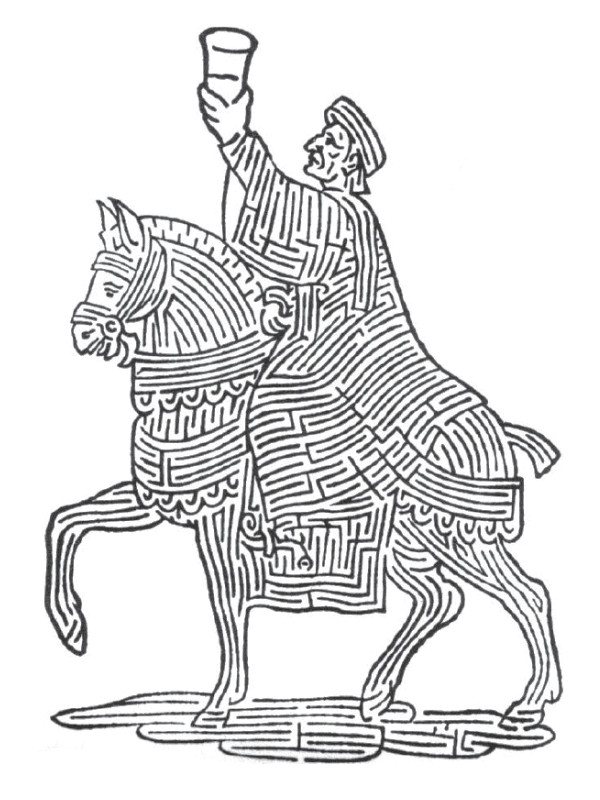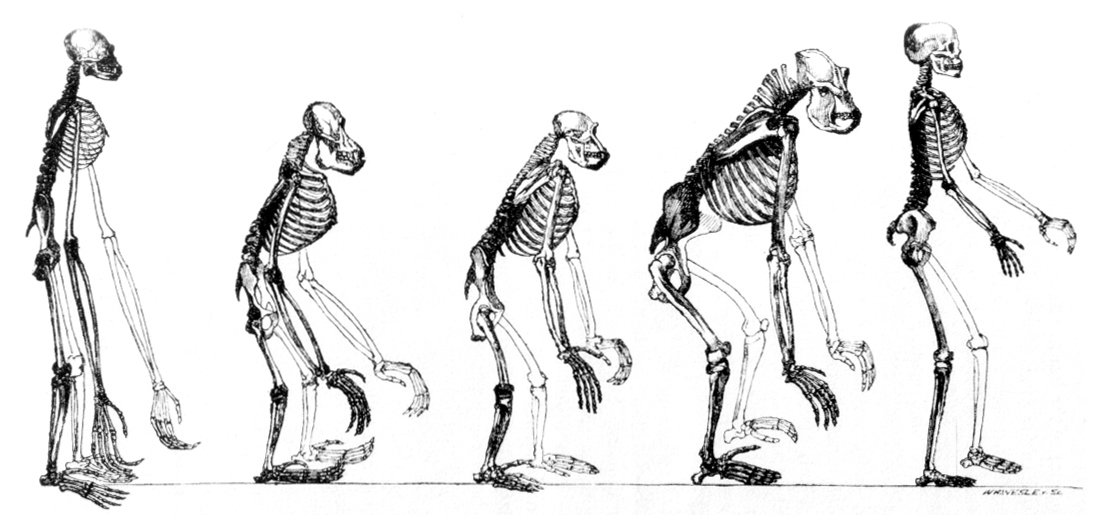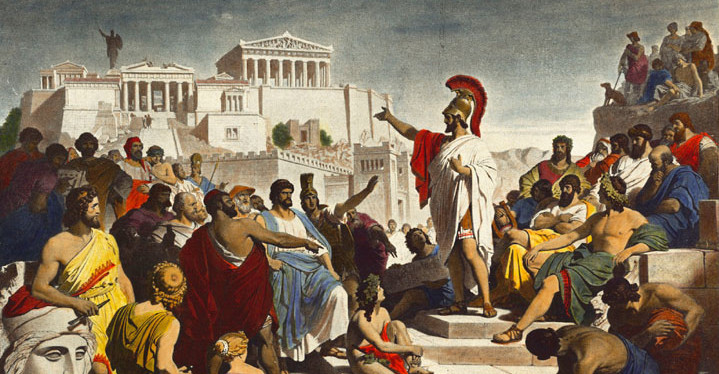
Francesco Segala (1535-1592) made his name as a sculptor in Padua, but he’s remembered as a father of the picture maze.
Make your way from the traveler’s cup to the exit at bottom center.

Francesco Segala (1535-1592) made his name as a sculptor in Padua, but he’s remembered as a father of the picture maze.
Make your way from the traveler’s cup to the exit at bottom center.
Mark two points on a line and label them 0 and 1, in that order. Now: In one move you can add or remove two neighboring points marked 0 0 or 1 1. Through a series of such moves, is it possible to arrive at a single pair of points labeled 1 0?
In 1931, 5-year-old Mel Brooks saw Frankenstein and refused open his window on a summer night. His mother talked to him:
Let’s say you are right. That Frankenstein wants to come here and kill you and eat you. But let’s look at all the trouble he’s going to have to get to Brooklyn. First of all, he lives in Transylvania. That’s somewhere in Romania. That’s in Europe. And that’s a long, long ways away. So even if he decides to come here, he has to get a bus or a train or hitchhike to somewhere he can get a boat to go to America. Believe me, nobody is going to pick him up. So let’s say he’s lucky enough to find a boat that would take him here. Okay, so he is here in New York City, but he really doesn’t know how the subways work. When he asks people they just run away! Finally, let’s say he figures out it’s not the IRT, it’s the BMT and he gets to Brooklyn. Then he’s got to figure out how to get to 365 South Third Street. Okay, it’s going to be a long walk. So let’s say he finally gets to Williamsburg and he finally finds our tenement. But remember, all the windows at 365 are going to be wide open and he’s had a long journey, so he must be very hungry. So if he has to kill and eat somebody, he probably would go through the first-floor window and eat all the Rothsteins who are living in apartment 1A. And once he’s full, there is no reason for him to go all the way up to the fifth floor and eat you.
“The story made good sense to me. ‘Okay,’ I said, ‘open the window. I’ll take a chance.'”
From his memoir, All About Me!, 2021.
“Thou jestedst when thou swor’st that thou betrothedst
The wench thou boastedst that thou lustedst for!
Thou thwartedst those thou saidst thou never loathedst,
But laudedst those that thou distrustedst more!
Ah, if thou manifestedst all thou insistedst,
Nor coaxedst those that thou convincedst not,
Nor vex’dst the ear thou wish’dst that thou enlistedst …”
“Thou’dst spit upon me less, thou sibilant sot!”
— R.A. Piddington

T.H. Huxley believed in the precept that magna est veritas et prævalebit — truth is great and will prevail.
“Truth is great, certainly,” he wrote, “but, considering her greatness, it is curious what a long time she is apt to take about prevailing.”
(From Evidence as to Man’s Place in Nature, 1863.)
“The liar’s punishment is not in the least that he is not believed, but that he cannot believe anyone else.” — George Bernard Shaw
Victorian riddler (and Bishop of Winchester) Samuel Wilberforce offered this conundrum:
I have a large Box, with two lids, two caps, three established Measures, and a great number of articles a Carpenter cannot do without. – Then I have always by me a couple of good Fish, and a number of a smaller tribe, – besides two lofty Trees, fine Flowers, and the fruit of an indigenous Plant; a handsome Stag; two playful animals; and a number of a smaller and less tame Herd: – Also two Halls, or Places of Worship; some Weapons of warfare; and many Weathercocks: – The Steps of an Hotel; The House of Commons on the eve of a Dissolution; Two Students or Scholars, and some Spanish Grandees, to wait upon me.
All pronounce me a wonderful piece of Mechanism, but few have numbered up the strange medley of things which compose my whole.
Lewis Carroll seems to have loved it — he circulated copies to his friends and published this solution in 1866:
The Whole — is Man.
The Parts are as follows.
A large Box — The Chest.
Two lids — The Eye lids.
Two Caps — The Knee Caps.
Three established Measures — The nails, hands and feet.
A great number of articles a Carpenter cannot do without, — Nails.
A couple of good Fish — The Soles of the Feet.
A number of a smaller tribe — The Muscles (Mussels).
Two lofty Trees — The Palms (of the hands).
Fine Flowers — Two lips, (Tulips), and Irises.
The fruit of an indigenous Plant — Hips.
A handsome Stag — The Heart. (Hart).
Two playful Animals — The Calves.
A number of a smaller and less tame Herd — The Hairs. (Hares).
Two Halls, or Places of Worship — The Temples.
Some Weapons of Warfare — The Arms, and Shoulder blades.
Many Weathercocks — The Veins. (Vanes).
The Steps of an Hotel — The Insteps. (Inn-steps).
The House of Commons on the eve of a Dissolution — Eyes and Nose. (Ayes and Noes).
Two Students or Scholars — The Pupils of the Eye.
Some Spanish Grandees — The Tendons. (Ten Dons).
verbarian
adj. relating to words
gasconade
n. boastful or bombastic language
philautia
n. self-conceit; undue regard for oneself
procacious
adj. cheeky, provocative
An odd little detail from Boswell’s Life of Johnson:
“His next instructor in English was a master, whom, when he spoke of him to me, he familiarly called Tom Brown, who, said he, ‘published a spelling-book, and dedicated it to the UNIVERSE; but, I fear, no copy of it can now be had.'”
Terms for times of day in the reckoning of the Malagasy people of Madagascar, from missionary James Sibree’s 1915 book A Naturalist in Madagascar:
midnight: centre of night; halving of night
2:00 a.m.: frog croaking
3:00 a.m.: cock-crowing
4:00 a.m.: morning also night
5:00 a.m.: crow croaking
5:15 a.m.: bright horizon; reddish east; glimmer of day
5:30 a.m.: colors of cattle can be seen; dusk; diligent people awake; early morning
6:00 a.m.: sunrise; daybreak; broad daylight
6:15 a.m.: dew-falls; cattle go out (to pasture)
6:30 a.m.: leaves are dry (from dew)
6:45 a.m.: hoar-frost disappears; the day chills the mouth
8:00 a.m.: advance of the day
9:00 a.m.: over the purlin
noon: over the ridge of the roof
12:30 p.m.: day taking hold of the threshold
1:00 p.m.: peeping-in of the day; day less one step
1:30–2:00 p.m.: slipping of the day
2:00 p.m.: decline of the day; at the rice-pounding place; at the house post
3:00 p.m.: at the place of tying the calf
4:00 p.m.: at the sheep or poultry pen
4:30 p.m.: the cow newly calved comes home
5:00 p.m.: sun touching (i.e. the eastern wall)
5:30 p.m.: cattle come home
5:45 p.m.: sunset flush
6:00 p.m.: sunset (literally, “sun dead”)
6:15 p.m.: fowls come in
6:30 p.m.: dusk; twilight
6:45 p.m.: edge of rice-cooking pan obscure
7:00 p.m.: people begin to cook rice
8:00 p.m.: people eat rice
8:30 p.m.: finished eating
9:00 p.m.: people go to sleep
9:30 p.m.: everyone in bed
10:00 p.m.: gun-fire
Native houses were built with their length running north-south and a single door and window facing west, so they served as rude sundials: By 9 a.m. the sun was nearly square with the eastern purlin of the roof, and at noon it stood over the ridge pole. As the afternoon advanced it peered in at the door and its light crept eastward across the floor, touching successively the rice-mortar, the central posts where the calf was fastened for the night, and finally the eastern wall.

Think of democracy as a machine. At fixed intervals, the preferences of individual citizens are fed into the machine, and it aggregates them and produces a “choice” of its own. Democratic rule is achieved if, when the machine isn’t working, its most recent choice is acted upon.
“The question now arises: What is the authority of the choice expressed by the machine?” writes philosopher Richard Wollheim. “More specifically, why should someone who has fed his choice into the machine and then is confronted by the machine with a choice non-identical with his own, feel any obligation to accept it?”
(Richard Wollheim, “A Paradox in the Theory of Democracy,” in Peter Laslett and W.G. Runciman, eds., Philosophy, Politics and Society, Second Series: A Collection, 1962.)